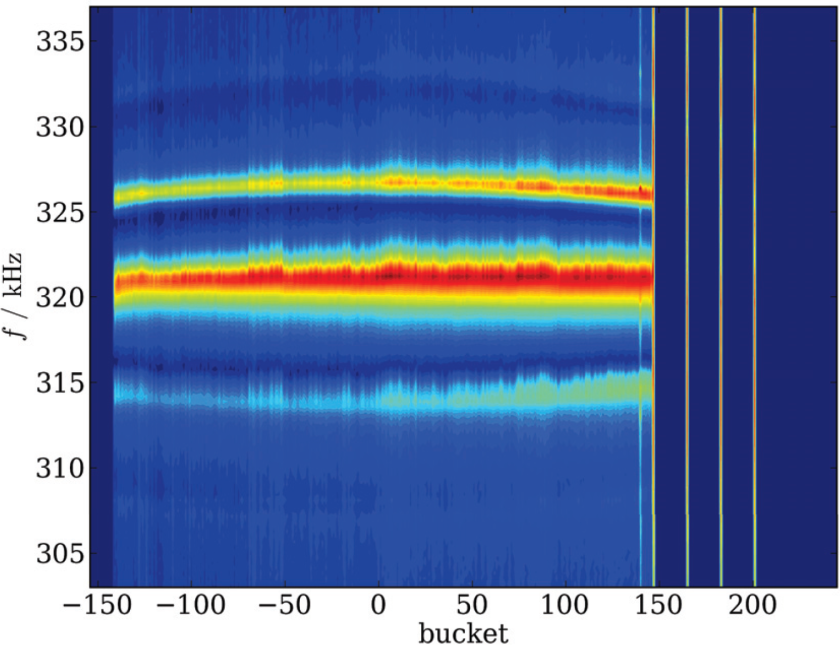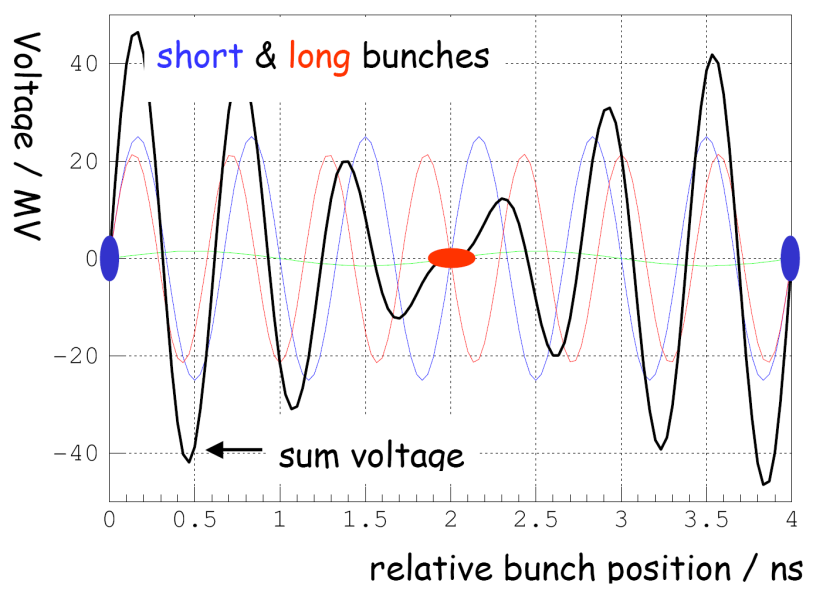Department Accelerator Operation, Development and Technology
Activities at BESSY II
After four years of construction Germany's first third generation synchrotron radiation source BESSY II started user operation in September 1998. For 15 years BESSY II has given scientists the opportunity to experiment in various fields of fundamental and applied research. The perpetual goal is the further development and optimization of the complete facility to significantly improve its performance and match the changing needs of the BESSY II user community. The G-IA try to fully understand the complete accelerator from the electron beam production till the radiation generation and work on step-by-step improved concepts.
Optimization of BESSY II User Operation
For the last 5 years great emphasis was given to the establishment of the BESSY II Top-Up Operation. In this injection mode the charge of each individual bucket is continuously refilled so that the average current stays constant. The advantage is not only a higher and more constant photon flux, but also the better thermal stability of the storage ring components resulting in a more stable electron beam orbit and photon beam position at the user endstations. The project required several major modifications: The installation of a new pre-injector LINAC, which can provide more flexible bunch filling patterns and more charge per single pulse than its microtron predecessor, constructing a new transferline to the Booster Synchrotron, upgrading the kicker and septa systems and the development of new safety interlock system with adequate injection efficiency measurement. Now Top-Up is a well reliable operation mode and completed as an stand-alone project.
One of the ongoing topics is the Fast Orbit Feedback. Here one needs to monitor and correct the stochastic disturbances of the electron beam created by ground motion and changing operating conditions of insertion devices. The proposed installation of new small-gap in-vacuum insertion devices will vary the impedance of the storage ring. This then alters the beam instability thresholds and places higher demands on the existing feedback systems operational at BESSY II. Within the renewal program the predated longitudinal and the analogue transverse feedback system will be digitally upgraded to improve the performance of the ring under this much more challenging condition. For example the injection transients of the stored beam during Top-Up injection experiments can be further reduced with a digital transverse feedback system.
In cooperation with MAXLab and Soleil, a new injection kicker system is under development. The standard method of beam accumulation with a local bump formed by four independent pulsed dipole kicker magnets causes beam oscillations on the already stored beam. The matching of the four independent kicker systems regarding pulse jitters and shapes is technologically limited. A new alternative injection was realized deploying a single non-linear kicker magnet with zero field in the center and off-axis maxima that are horizontally displaced by few millimeter. In this method only the injected beam is kicked and already accumulated electron bunches ideally remain undisturbed. After successful tests at BESSY II, reducing the introduced oscillation amplitude by a factor of 10, an improved kicker is going to be installed.
Addition tests of so-called Pseudo Single Bunch Mode are also under investigation. By exiting a single bunch out of 300 stored, it performs betatron oscillations around the nominal orbit. User stations, whose experiments demand a much lower bunch repetition rate, can be tuned to be only sensitive on this special trajectory and see a photon pulse structure which corresponds to a single bunch in the storage ring. This trick enables more flexible beam time for users.
Further interest is the improvement of the user magnet optics for the new Top-Up mode (better injection efficiency), the low-alpha mode for picosecond photon pulse durations (single bunch instabilities causing beam loss) and for the Energy Materials In-Situ Laboratory ( EMIL) project which using state of the art insertion devices, new beam lines and experiment preparation.
Last publications:
- A. Schälicke et al., Status and Performance of Bunch-by-bunch Feedback at BESSY II and MLS, Proceedings of IPAC2014, Dresden, Germany, pp. 1733 JACoW.org
- K. Holldack et al., Single Bunch X-Ray Pulses on Demand from a Multi-Bunch synchrotron Radiation Source, Nat. Commun. 5, 4010 (2014) DOI:10.1038/ncomms5010
- A. Schälicke et al., Bunch-By-Bunch Feedback and Diagnostics at BESSY II, Proceedings of IBIC2013, Oxford, England, pp. 399 JACoW.org
- P. Kuske, CSR-Driven Longitudinal Single Bunch Instability Thresholds, Proceedings of IPAC2013, Shanghai, China, pp. 2041 JACoW.org
- R. Müller et al., Fast Orbit Feedback at BESSY-II: Performance and Operational Experiences, Proceedings of IPAC2013, Shanghai, China, pp. 2920 JACoW.org
- P. Schmid, Modifications of the Machine Optics of BESSY II Necessitated by the EMIL Project, Proceedings of IPAC2012, New Orleans, USA, pp. 1614 JACoW.org
- O. Dressler et al., Development of a Non-Linear Kicker System to Facilitate a New Injection Scheme for the BESSY II Storage Ring, Proceedings of IPAC2011, San Sebastián, Spain, pp. 3394 JACoW.org
- P. Kuske, Longitudinal Beam Dynamics of a Laser Sliced Bunch, Proceedings of IPAC2011, San Sebastián, Spain, pp. 3397 JACoW.org
- T. Atkinson, Commissioning of the 50 MeV Preinjector Linac for the BESSY II Facility, Proceedings of IPAC2011, San Sebastián, Spain, pp. 3140 JACoW.org
Collaborations:
- Non-linear kicker - Soleil Synchrotron Company (France), MAX-Laboratory (Sweden)
The BESSY Alternating Bunch Length Upgrade Proposal: BESSY VSR
BESSY VSR is a novel approach to create in the Storage Ring BESSY II long and short photon pulses simultaneously for all beam lines through a pair of superconducting bunch compression cavities. These two cavities run at different frequencies to produce a beating of the sum voltage. Long bunches are placed where the voltage cancels, short bunches are placed where the voltage adds up. Pulse-picking schemes will allow each individual user to freely switch between high average flux for X-ray spectroscopy, microscopy and scattering and picosecond pulses up to 500 MHz repetition rate for dynamic studies. Thus BESSY VSR preserves the present average brilliance of BESSY II and adds the new capability of user accessible picosecond pulses at high repetition rate.
The investigations with X-rays from BESSY VSR are highly complementary and compatible to dynamic studies conducted by users with optical lasers at their home universities and laboratories. BESSY VSR represents also a missing link between the extreme average brilliance of ultimate storage rings like PETRA III and Free Electron Lasers. Technologically, the employed superconducting bunch compression cavities in BESSY VSR are a direct synergy to the CW superconducting cavities developed for bERLinPro.
The figure illustrates the amplitude beating of the voltages of the two superconducting cavities. In places, where the voltage adds up a strong longitudinal focusing exists and bunches are compressed to 1.5 ps (rms) length. In places where these voltages cancel each other out long bunches of 15 ps (rms) are produced. Both types of bunches are stored simultaneously in the ring.
Beam dynamics work for BESSY VSR is presently focused on beam cavity interactions, i.e. multi bunch instabilities, and properties of short bunches, supported by experimental studies at the Metrology Light Source.
Contact:
andreas.jankowiak@helmholtz-berlin.de, godehard.wuestefeld@helmholtz-berlin.de
Last publications:
- A. Neumann et al., First Cavity Design Studies for the BESSY-VSR Upgrade Proposal, Proceedings of IPAC2014, Dresden, Germany, pp. 2493 JACoW.org
- M. Ruprecht et al., Analysis of Coupled Bunch Instabilities in BESSY-VSR, Proceedings of IPAC2014, Dresden, Germany, pp. 1659 JACoW.org
- P. Goslawski et al., The Low-alpha Lattice and Bunch Length Limits at BESSY-VSR, Proceedings of IPAC2014, Dresden, Germany, pp. 216 JACoW.org
- M. Ruprecht et al., Single Particle Tracking for Simultaneous Long and Short Electron Bunches in the BESSY II Storage Ring, Proceedings of IPAC2013, Shanghai, China, pp. 2038 JACoW.org
- A. Jankowiak and G. Wüstefeld, Low-Alpha Operation of BESSY II and Future Plans for an Alternating Bunch Length Scheme BESSY VSR, Synchrotron Radiation News, Vol. 26, No. 3, 2013 DOI:10.1080/08940886.2013.791212
- G. Wüstefeld et al., Simultaneous Long and Short Electron Bunches in the BESSY II Storage Ring, Proceedings of IPAC2011, San Sebastián, Spain, pp. 2936 JACoW.org
Support:
- BMBF - FKZ: 05K13PEB & 05K13HR1 - 'Superconducting cw-multicell resonators'


